Flying Santa’s Lighthouse Connection Still Shines Bright
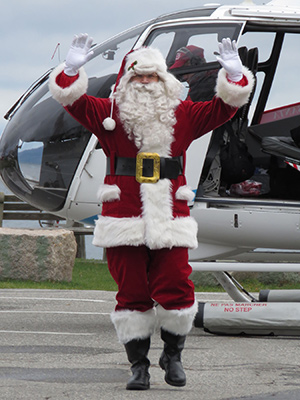
(Photo by Bob Trapani, Jr.)
The Yuletide season is like no other time of year. Joy and kindness shine their brightest – and opportunities for memory-making are as boundless as the sparkle that embodies the Christmas holiday itself. Traditions are celebrated, benevolence radiates and young and old alike bask in a sea of lights aglow that beckon one’s imagination to take flight on the wings of festivity.
When it comes to Christmas traditions taking flight along the New England coast at lighthouses and Coast Guard stations, none outshine the time-honored Flying Santa. Since 1929, the Flying Santa has been bringing gifts, smiles and Christmas cheer to those who keep our waters safe.
This heartwarming holiday mission, which has spanned from Capt. Bill Wincapaw to Edward Rowe Snow and the Hull Lifesaving Museum to the Friends of Flying Santa, reached its 90th year in 2019.
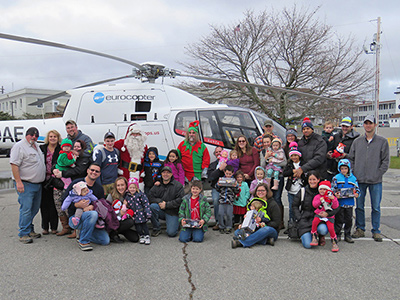
(Photo by Bob Trapani, Jr.)
Brian Tague, President of the Friends of Flying Santa, says, “Our mission remains dedicated to Captain William Wincapaw and Edward Rowe Snow’s philosophy that lighthouse keepers and Coast Guard crews were true lifesavers and deserved to be recognized for their efforts. As long as there are boat station crews, aids to navigation teams and other units serving to keep our waters safe, we will do our part to remind them of how much their work is appreciated.”
Over these nine decades, the inevitable winds of change have steadily blown across the seascape of time, eventually relegating lighthouse keepers and their families to the pages of history. The Flying Santa can no longer visit staffed light stations and share with them gift packages dropped from the air. It seems the connectivity of lighthouses to the Flying Santa tradition would have been lost during the relentless march of progress.
Thankfully, this is not the case!
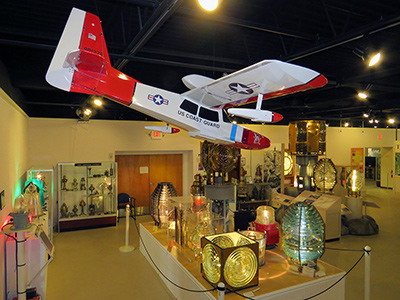
(Photo by Bob Trapani, Jr.)
The Flying Santa’s lighthouse connection remains an important part of the holiday mission. In fact, the Jolly Fella still includes a few historic beacons on his long list of Christmastime stops each year.
However, today, the Flying Santa’s finest lighthouse visit is not even a sentinel at all. Rather, it is a place that preserves within its hallowed halls of history the spirit of Maine’s guiding lights and their bygone keepers – sharing the best of both with visitors from all over the world.
This place is the Maine Lighthouse Museum in Rockland – founded by Ken Black and a must see for anyone interested in our lightkeeping heritage. Here, Fresnel lenses of nearly every size glimmer in alluring fashion, fog horns – though silent, uniquely remind visitors of the dreaded vagaries of the sea, and human interest accounts of those who tended the lights inspire at every turn.
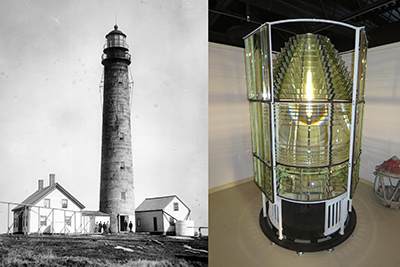
(National Archives and Bob Trapani, Jr. photos respectively)
And since Capt. William Wincapaw began his first Flying Santa runs out of the Rockland area, the Maine Lighthouse Museum is quite possibly the most historically-connected stop along this multi-state effort.
The very lights and keepers that originally inspired Capt. Wincapaw to take to the skies and spread Christmas cheer to far-flung places like Petit Manan, Matinicus Rock, Mount Desert Rock, Saddleback Ledge and others are still part of this grand tradition in many ways thanks to stunning array of artifacts that are preserved and exhibited at the Maine Lighthouse Museum.
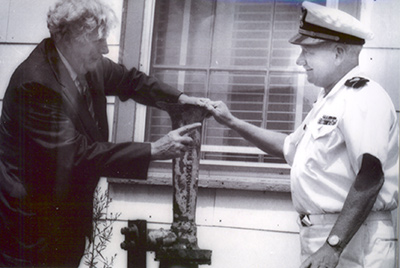
(Maine Lighthouse Museum photo)
Dorothy Black, Director of the Maine Lighthouse Museum, is a long-time supporter of the Flying Santa. Her association with this delightful holiday tradition goes back many years. “It was twenty-three years ago when my late husband USCG CWO Ken Black introduced me to one of his favorite events – the Flying Santa,” said Dorothy Black. “During Ken’s service in the Coast Guard, he had the opportunity to work with the second Flying Santa – Edward Rowe Snow, on a number of occasions.”
Black went on to say, “I’ll always remember clearly the sight of seeing that blue helicopter flying overhead with the man in the red suit. I read a lot of Edward Rowe Snow’s books and a number of articles on the Flying Santa. I could not get enough history about this Christmas tradition.”
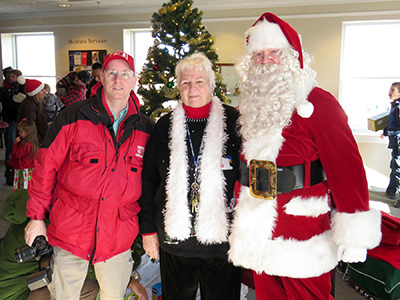
(Photo by Bob Trapani, Jr.)
In addition to serving as the Director of the Maine Lighthouse Museum, Dorothy Black was also the driving force behind the City of Rockland becoming the eighth Coast Guard City in the United States – a designation officially recognized on June 16, 2008.
Her commitment to lighthouses and the Coast Guard proved a natural fit when it came to helping the Friends of Flying Santa find a new landing place in Rockland once the growth of trees in the parking lot at Owls Head Light made it more challenging for Flying Santa’s helicopter to land in recent years.
“We had to find a different spot than Owls Head Light,” said Dorothy Black, “so we went to the Coast Guard pier in Rockland, but that didn’t work either. So where else but the Maine Lighthouse Museum?” In her typical tireless fashion, Black made it happen.
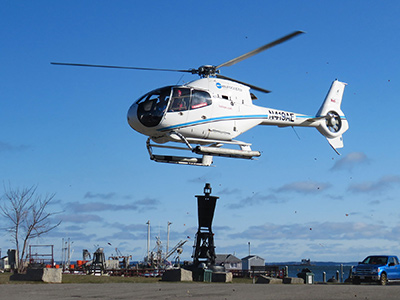
(Photo by Bob Trapani, Jr.)
Black knew that there was ample space for the helicopter to land at Middle Pier in Rockland, which is adjacent to the Maine Lighthouse Museum, but there were other factors to consider. “Then, concern for the safety of my pilot friends guiding the ‘sleigh’ (helicopter) with Santa and Brian Tague came into play as it related to pedestrians, parked cars and vehicle traffic around the pier,” said Dorothy Black. “Thanks to the City of Rockland Police Chief Bruce Boucher, he believed they could do it, so middle pier became the new spot in 2012. Flying Santa has been landing at this location ever since.”
When the Flying Santa lands at Middle Pier, he is escorted up to the Maine Lighthouse Museum in a Rockland police vehicle. Once he enters the Museum, he not only greets children from the four Coast Guard units in Rockland, his visit also ensures that Flying Santa’s rich lighthouse heritage remains connected too.
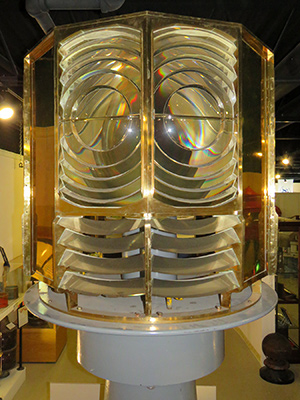
(Photo by Bob Trapani, Jr.)
For inside the Maine Lighthouse Museum’s exhibit hall, the second order Fresnel lens from Petit Manan and the third order Fresnel lens from Matinicus Rock are glimmering bridges of light back to a time when these same lenses helped guide Captain Wincapaw on flights along the coast for the Curtis Flying Service in Rockland back in the 1920s.
The lenses were in service during all of the Flying Santa flights when the lights were staffed. Inside the Museum is also representative dinnerware and brassware that would have been at the lights during this era – as well as a plethora of accounts that tell of the golden era of Maine’s lighthouses.
The connections to Flying Santa and Maine’s sentinels at the Maine Lighthouse Museum are many – all of which comprise one fascinating story!
But for all the lighthouse connections that abound, the Flying Santa is still the ‘star of the show’ for the children of Coast Guard families. The exuberance and pure joy on the children’s faces when they see Flying Santa and receive a gift from him is nothing short of memorable.
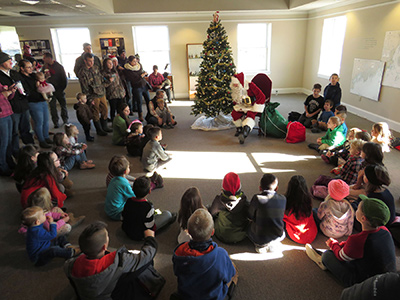
(Photo by Bob Trapani, Jr.)
Dorothy Black sums up the Flying Santa experience by recounting a few of the comments made by children and their parents. “I hear things like, ‘wow,’ ‘this is awesome,’ ‘what a great tradition – keep it going, ‘by helping keep the tradition going, it is a tribute to the Coast Guard,’ ‘the children’s faces – just look at them, they are in awe!’”
The children’s radiant faces and beaming smiles, coupled with the lenses gleaming and the sparkle of lighthouse history make the Flying Santa’s visit to the Maine Lighthouse Museum the most wonderful connection to this Christmastime tradition. May it continue to shine forth over the sea of time!
How did the Flying Santa Tradition Begin?
Brian Tague, President of the Friends of Flying Santa, explains:
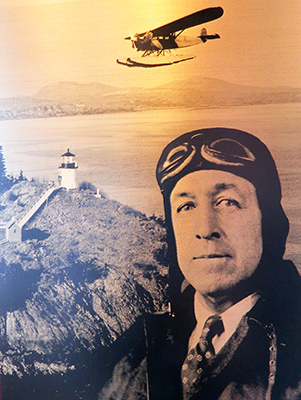
(Maine Lighthouse Museum photo)
“It all began back in 1929 with a Maine floatplane pilot by the name of William Wincapaw. Capt. Wincapaw, a native of Friendship, had been a pioneer in the early days of aviation. He was well known around the Penobscot Bay area as a skilled and adventurous pilot. He flew a variety of aircraft but was most at home in amphibious airplanes.
“The landscape of Penobscot Bay being made up of numerous islands, floatplanes had become a most practical means of transport. At this time, Capt. Wincapaw was overseeing operations of the Curtis Flying Service at the Rockland airfield as well as the nearby seaplane base. There were many occasions when he took to the air in less than ideal conditions to provide transport for sick or injured islanders. His actions were responsible for the saving of many lives.
“On many of these flights, his only means of navigation were the lighthouse beacons along the coast. His appreciation of the keepers and their dedication to keeping these lights well-lit and their surrounding waters safe, grew each time he found himself making a flight in the worst of weather. When he was out and about, the keepers would keep a watchful eye out for his plane. They made it a habit to relay word back to the airfield whenever he had safely passed their position.
“On calmer days, Capt. Wincapaw would often land at a local light, tie up his aircraft and spend some time chatting with the keepers. He had a great deal of admiration for these men and their families and felt that something special should be done to show them how much their efforts were appreciated.
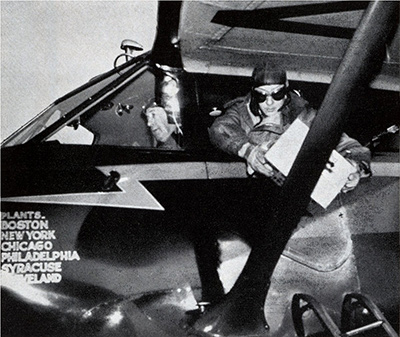
(Friends of Flying Santa photo)
“So it began on December 25, 1929, he loaded his plane with a dozen packages containing newspapers, magazines, coffee, candy and other items. They were small luxuries and common staples that could make living on an isolated island a little more bearable. Some of these same items continue to be a part of the tradition today. He flew to lights around the Rockland area and dropped these modest gifts to the lighthouse families. Never realizing just how well his gesture of Christmas goodwill would be received, he flew home to spend the rest of the day with his family.”
We stayed at Rockland, Maine a few years ago with my oldest son’s family. We toured the museum and enjoyed the small town life. We even walked on the breakwater. I never knew what a beakwater was until we visited Maine. Our visit is one of our most treasured vacations.
The first year my husband and I were married, we were stationed on Eagle Island lighthouse and was surprised with the package drop from the plane. My husband was a relief lighthouse keeper.